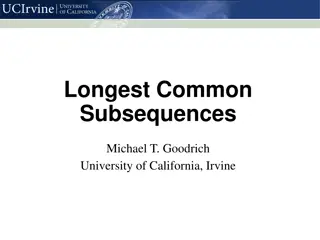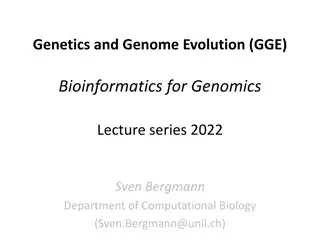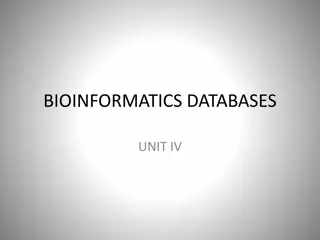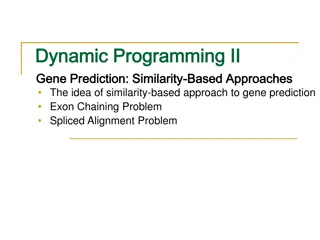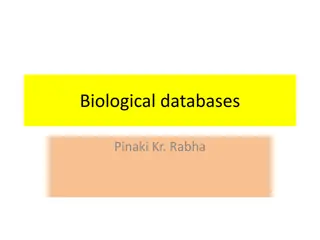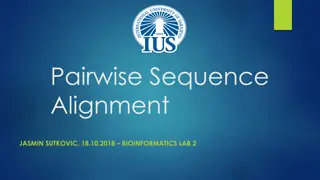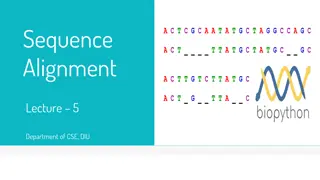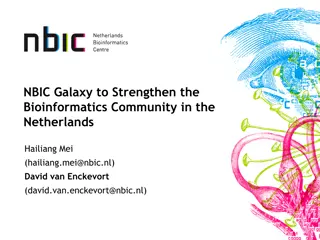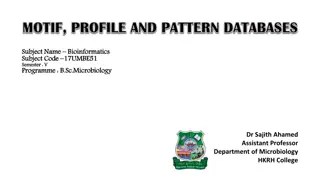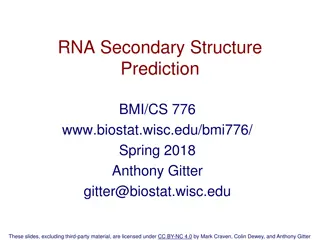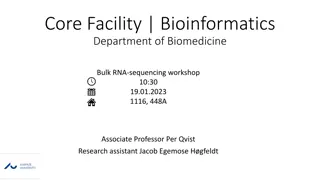Bioinformatics
Bioinformatics involves analyzing biological sequences through sequence alignment to uncover functional, structural, and evolutionary insights. This process helps in tasks like annotation of sequences, modeling protein structures, and analyzing gene expression experiments. Basic steps include comparing sequences to identify similarities, gene structures, and mutations, revealing genetic diversity, and annotating gene functions. Terms like sequence identity, similarity, and homology are important in sequence comparison. An example like the chain-termination method illustrates sequence alignment visually.
Download Presentation

Please find below an Image/Link to download the presentation.
The content on the website is provided AS IS for your information and personal use only. It may not be sold, licensed, or shared on other websites without obtaining consent from the author.If you encounter any issues during the download, it is possible that the publisher has removed the file from their server.
You are allowed to download the files provided on this website for personal or commercial use, subject to the condition that they are used lawfully. All files are the property of their respective owners.
The content on the website is provided AS IS for your information and personal use only. It may not be sold, licensed, or shared on other websites without obtaining consent from the author.
E N D
Presentation Transcript
1 UNIVERSITY OF BASRAH / COLLEGE OF SCIENCE Bioinformatics What is Sequence? 1 Why SequenceAlignment ? 2 Basic Steps in SequenceAlignment 3 Terms of sequence comparison 4 Prof.Dr. Saad S. Mahdi Al-Amara LECTURE PhD. 4
2 Sequence Alignment What is Sequence ? Biological sequence is a single, continuous molecule of nucleic acid or protein.Sequence analysis in bioinformatics is an automated, computer-based examination of characteristic fragments, e.g. of a DNAstrand. The term "sequence analysis" in biology implies subjecting a DNA or peptide sequence to sequence alignment, sequence databases, repeated sequence searches, or other bioinformatics methods on a computer.
3 SequenceAlignment Why SequenceAlignment ? For discovering functional, structural and evolutionary information in biological sequences . 1 Eases further tasks like: 2 Annotation of new sequences . A Modeling of protein structures . B Design and analysis of gene expression experiments . C
4 Sequence Alignment Basic Steps in SequenceAlignment Comparison of sequences to find similarity and dissimilarity in compared sequences . Identification of gene-structures, reading frames, distributions of introns and exons and regulatory elements . Finding and comparing point mutations to get the genetic marker . Revealing the evolutionary and genetic diversity . Function annotation of genes.
5 SequenceAlignment Sequence alignment involves the identification of the correct location of deletions and insertions that have occurred in either of the two lineages since the divergence from a common ancestor. Terms of sequence comparison Sequenceidentity: Exactly same Nucleotide/AminoAcid in same position Sequencesimilarity: Substitutions with similar chemical properties Sequencehomology: General term that indicates evolutionary relatedness among sequences 11
6 SequenceAlignment Example :a chaintermination method The sequence is represented by a series of peaks, one for each nucleotide position. In this example, a red peak is an T, blue is a C, Black is a G, and green is a A.



